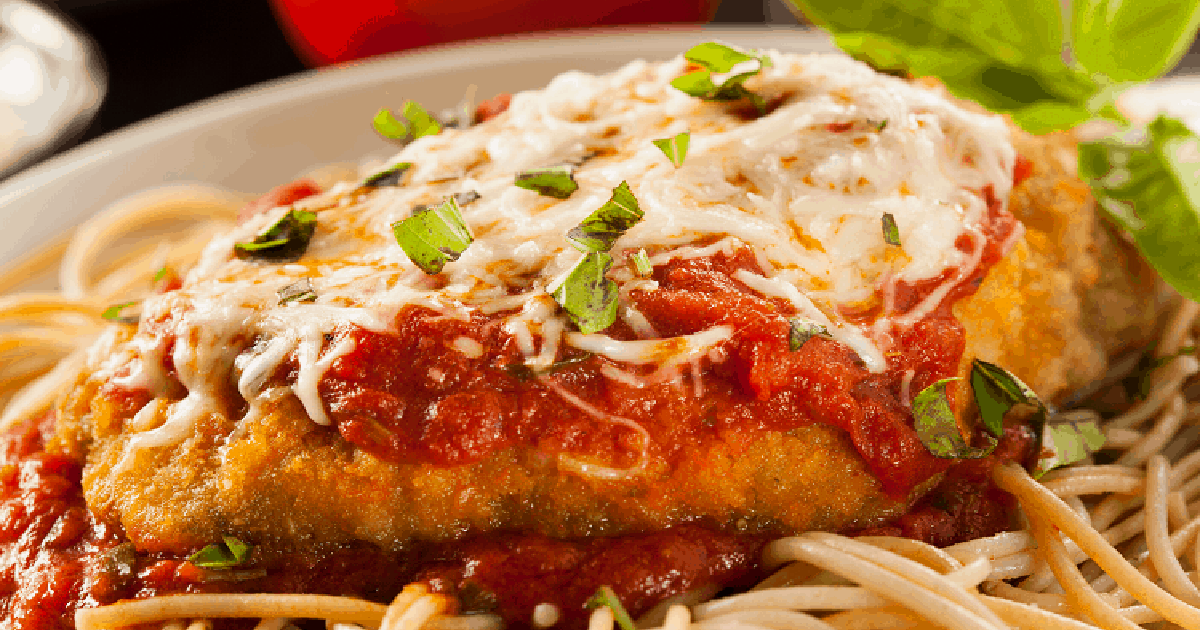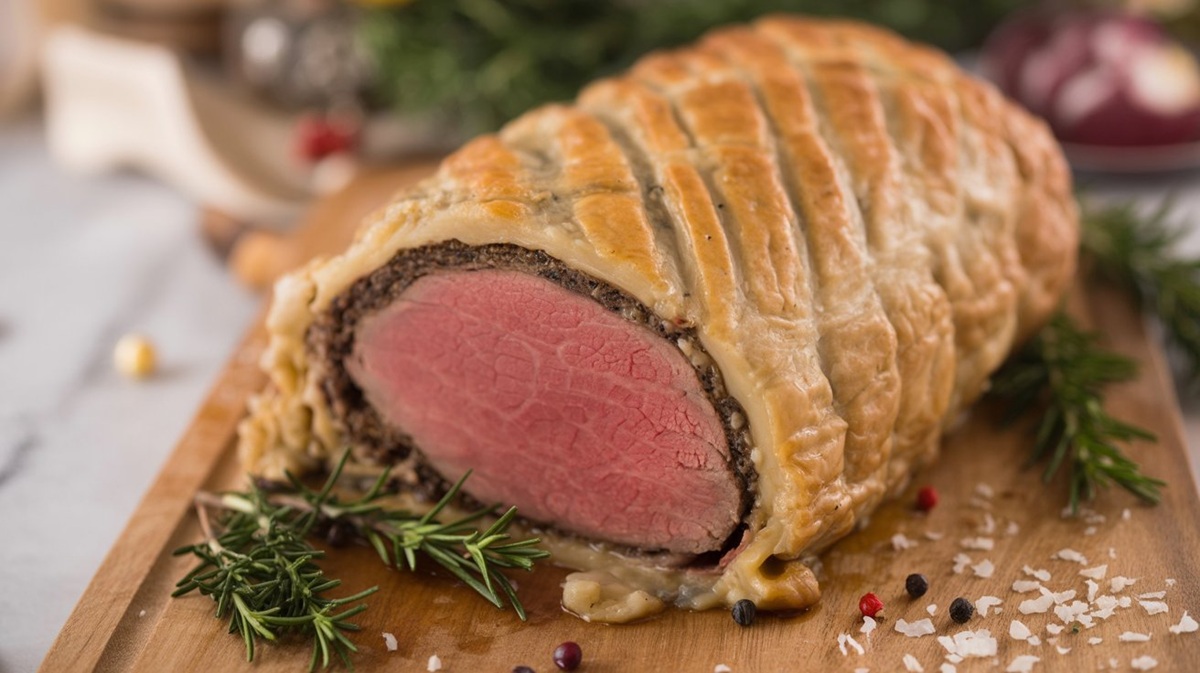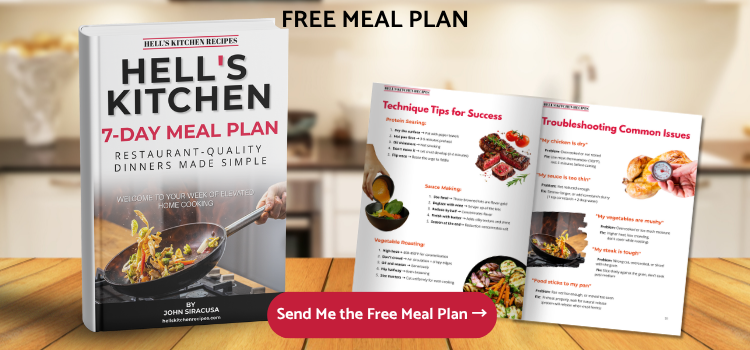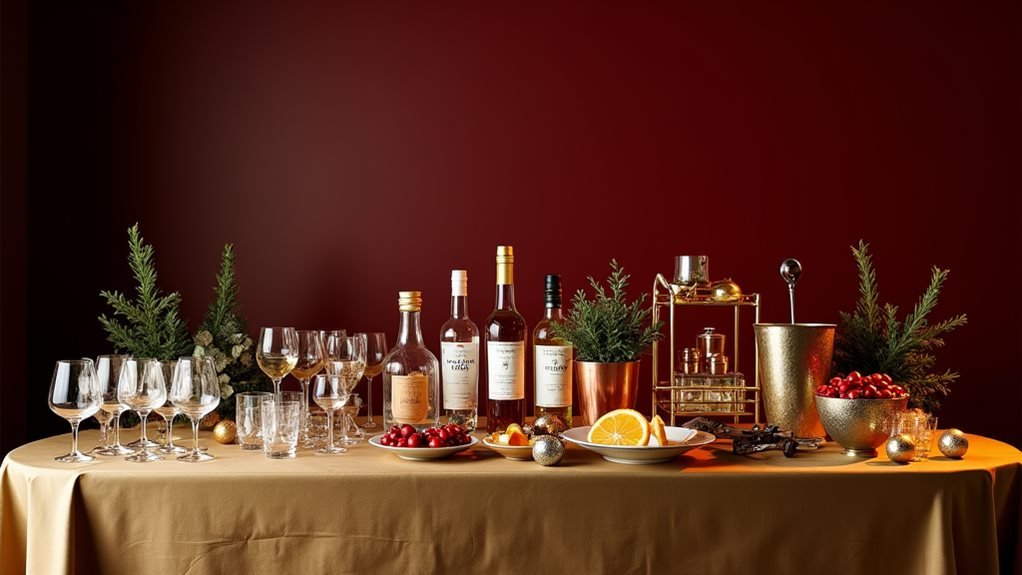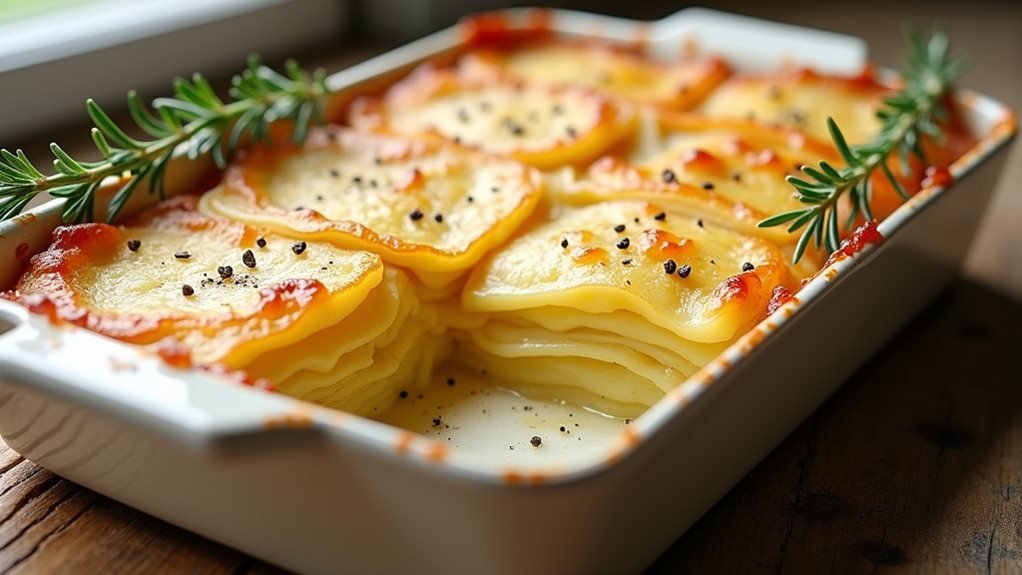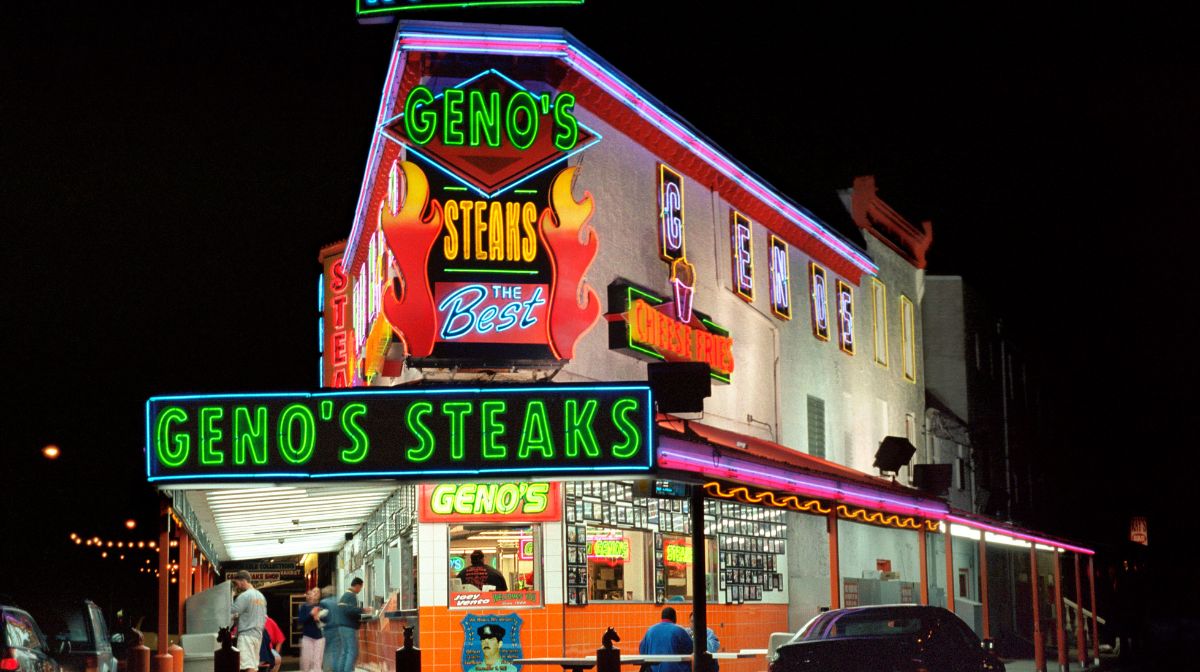What Makes Gordon Ramsay’s Chicken Parm Different?
Many chicken parm versions turn out heavy or soggy. Ramsay’s approach focuses on even cutlet thickness, a three-stage dredge (flour → egg → panko with Parmesan), and a short chill to set the coating. The goal isn’t just flavor; it’s structure—so the crust survives sauce and cheese. For more frying techniques, see our Crispy, Juicy Fried Chicken guide.
How to Achieve a Golden-Brown, Crispy Crust
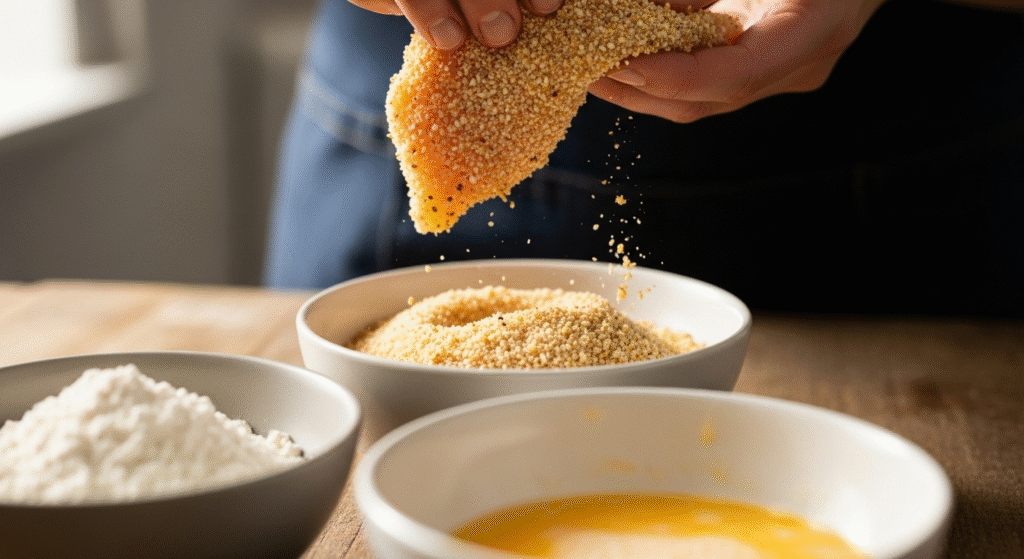
What actually keeps the crust crisp from skillet to table? These principles do the work:
- Pound evenly to 1/4–3/8 inch. Consistent thickness cooks fast without tearing the crust.
- Dry, then season. Surface moisture inhibits adhesion; salt/pepper seasons the meat, not just the coating.
- Three-stage dredge. Flour grips the protein, egg grips the flour, panko+Parmesan builds crunch and savor.
- Chill the breaded cutlets. Ten to fifteen minutes on a rack sets the coating so it won’t slip.
- Control oil heat (325–350°F) and fry in batches. Too cool = greasy; too hot = scorched crust, undercooked center. Confirm doneness with a thermometer (poultry is safe at 165°F).
- Drain on a wire rack. Airflow prevents steam from softening the crust, while paper towels trap the steam.
The Role of Sauce and Cheese in Chicken Parm
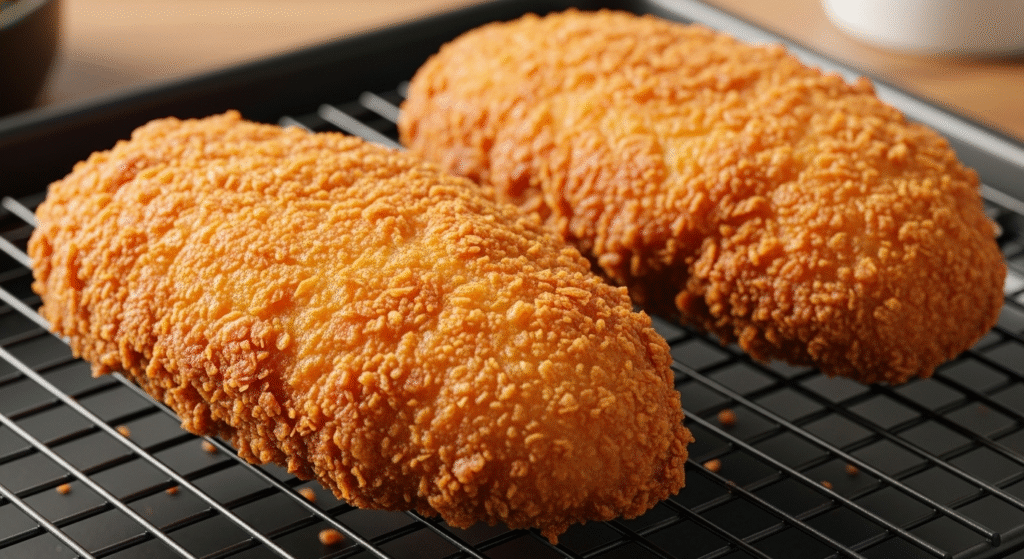
Balance matters. Use low-moisture mozzarella for a clean melt and light browning; fresh mozzarella tastes great, but it releases water that softens the crust. Keep the sauce layer restrained—enough to coat, not drown—then finish under high heat so the cheese bubbles quickly without soaking the coating. For melt and moisture behavior, see this mozzarella comparison.
| Cheese | Behaves Like | Use When You Want |
|---|---|---|
| Low-moisture mozzarella | Even melt, slight browning, minimal water | Crisp crust preserved; clean, stretchy topping |
| Fresh mozzarella (fior di latte) | Creamy melt, higher moisture | Richer dairy flavor—pat dry and use lightly |
| Parmesan in the breading | Nutty, savory crust; helps browning | Deeper flavor without weighing down the top |
Is Chicken Parmesan Authentic Italian?
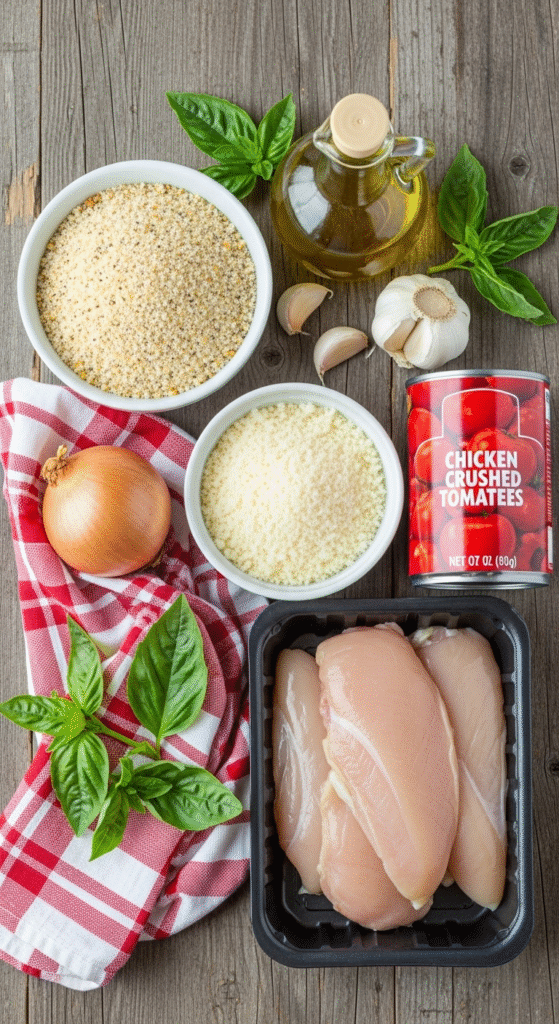
Short answer: It’s Italian-American. The technique evolved from melanzane alla parmigiana (eggplant parmigiana), adapted by immigrants who substituted chicken for eggplant. See background from La Cucina Italiana and a concise overview of Chicken Parmesan. For more Italian-inspired comfort dishes, try Gordon Ramsay’s Chicken Cacciatore.
Common Mistakes and How to Avoid Them
- Skipping the flour step. Without it, the coating slides. Keep the dry-wet-dry order.
- Overcrowding the pan. Temperature drops, and the crust soaks oil; fry in batches. Brush up on our frying technique guide.
- Using water-heavy cheese. Pat fresh mozzarella dry or choose low-moisture.
- Drowning in sauce. Spoon a thin layer, then broil to set the top fast.
- Resting on paper towels. Use a rack to promote airflow and keep the underside crisp.
Can You Make Ramsay Chicken Parm Lighter?
Yes. For baked or air-fried cutlets, elevate on a rack, mist lightly with oil, and finish under the broiler. You’ll trade a little depth of flavor for easier cleanup and less oil. Gluten-free panko and dairy-free cheeses also work if you keep the same adhesion and moisture-control principles.
What We Learned Testing This Recipe
Consistency wins: pounding evenly, chilling breaded cutlets, maintaining oil heat, and saucing with restraint produced the most reliable results. Low-moisture mozzarella preserved crunch best; a bright tomato sauce balanced richness without soaking the crust.
FAQs About Gordon Ramsay’s Chicken Parm
Why doesn’t chicken parmesan always use only Parmesan?
Parmesan delivers nutty savor in the breading or as a finish, while mozzarella gives the characteristic melt and stretch.
What oil is best for frying?
Neutral, high-heat oils (grapeseed, canola, peanut) hold steady temps and keep flavors clean.
Can I prep cutlets ahead?
Yes. Bread and chill up to a day, or freeze on a sheet pan and store. Cook from frozen; extend time slightly and verify doneness (chicken is safe at 165°F).
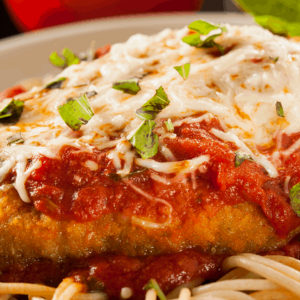
Gordon Ramsay Chicken Parm
Ingredients
For Tomato Sauce
- 4 Tbsp. grapeseed or Avocado oil
- 6 Roma tomatoes, diced
- 2 cans 28 Oz. crushed tomatoes
- 4 tablespoons basil chiffonade
- 3 garlic cloves
- 1/2 yellow onion
Breading Chicken for Chicken Parmesan
- 4 oz Grated Parmesan cheese
- 1 Tbsp. Parsley finely chopped
- 1 Tbsp. Fresh oregano finely chopped
- 2 C. Japanese Panko Breadcrumbs
- 1 tsp. Paprika
- 3 Whole eggs
- 1 C. All-purpose flour
- 1 tsp. Kosher salt
- 1 pinch of cracked black pepper
Chicken Parmesan
- 4 Breaded Cutlets
- 1/3 C. grapeseed or avocado oil for frying
- 1-2 Spoonful of Tomato Sauce
- 2 8 Oz. Fresh mozzarella balls, cut into ¼ in. thick round
For Spaghetti
- 1 lb. Dry Spaghetti
- 1 Tbsp. Oil Olive
- 1 Tbsp. Parsley finely chopped
- 1 Tbsp. Basil chiffonade
- 1 Oz. Parmesan cheese
Instructions
For Tomato Sauce
- Heat 4 Tbsp. Grapeseed or Avocado oil over medium heat in 6 qt. saucepan
- Add yellow onion and garlic, sweat out till onion is transparent
- Add Roma tomatoes to the onion and garlic; let them cook for 5 minutes.
- Now add the canned tomatoes, lower the heat, bring it to a simmer, and cook for 20 minutes until the sauce in a third shallow pan is lightly thickened.
For Breading Chicken
- In a shallow pan, seasoned flour with salt and pepper.
- Whisk the eggs and add a second shallow pan.
- Mix the panko with grated parmesan cheese, chopped parsley, fresh oregano, and paprika in a third shallow pan.
- Season each cutlet to taste with salt and pepper.
- Coat in the flour, the egg, and Japanese panko mix to coat thoroughly.
Chicken Parmesan
- Heat 1/3 cup of grapeseed or avocado oil in a large sauté pan to 350 degrees.
- Place two breaded cutlets in the hot oil.
- Cook on each side for 2-3 minutes or until Golden Brown.
- Place on a wire rack to rest.
- Now add 1-2 spoonfuls of sauce on top of the centers of the cooked chicken.
- Place a few slices of mozzarella on top of the sauce and broil in the oven to melt the cheese.
For Spaghetti
- Bring a large stockpot of salted water to boil.
- Add dry spaghetti and cook for 10-12 minutes or until al dente.
- Drain pasta in a colander.
- Then, Coat pasta with a few tablespoons of sauce, salt, pepper, chopped parsley, chopped basil, and grated parmesan cheese.
